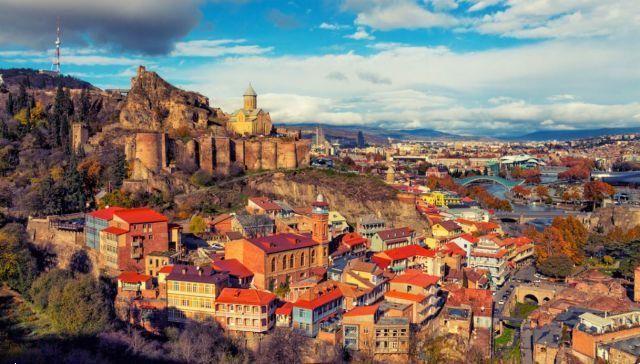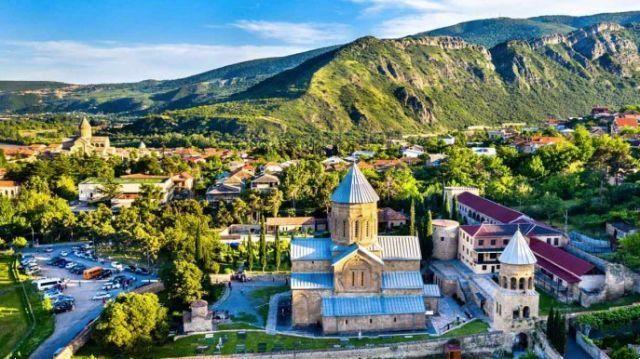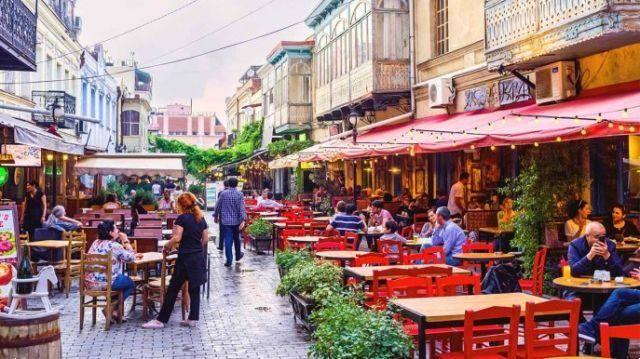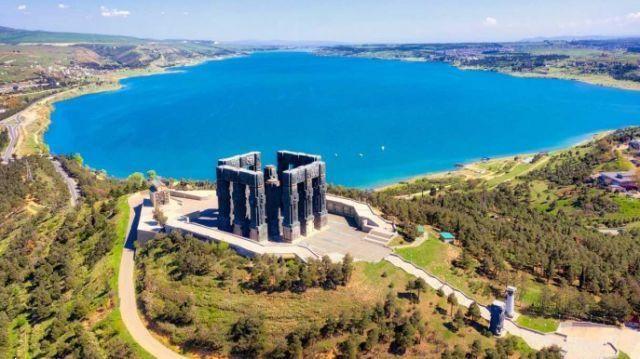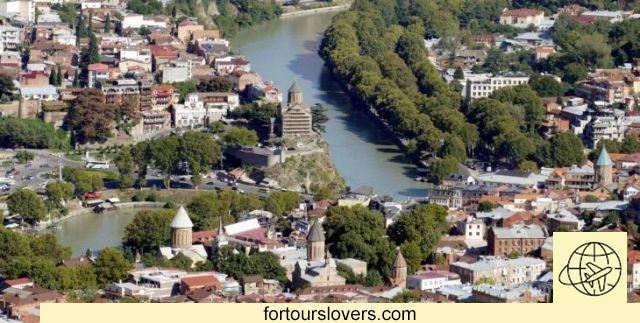
Tbilisi
10 things to do and see in Tbilisi and 2 not to doTbilisi, the capital of Georgia is the only truly metropolitan expression of this country with a still strongly rural identity.
Founded 6000 years ago, in a strategic position for the ancient trade routes between Asia and Europe, today Tbilisi is a very lively city, which combines the past and the contemporary in a captivating fusion. The historic center, at the foot of the fortress, retains the imprint of a Eurasian crossroads: spas, maze of narrow streets, artisan shops, cafes, churches and houses with characteristic wooden loggias. It contrasts the international standard of the Rustaveli area - Liberty Square and Rustaveli metro stops - with its very long tree-lined avenue, nineteenth-twentieth-century buildings, museums, design hotels and even a very modern shopping center, Galleria Tbilisi, 7 floors, one of which entirely dedicated to fast food and another to cinema and bowling. A neighborhood to consider, for those who want a more informal, boho chic style, is Agmashenebeli on the left bank of the Kura River, Marjanishvili metro stop.
Tbilisi has many other arrows in the arc of its tourist offer: you spend little, you eat well, and you drink (Georgian wines are famous) even better.
1 Peace Bridge
Let's start with a symbol of the city: the Bridge of Peace. It is a pedestrian bridge designed by the Italian Michele De Lucchi, an architect who has signed other important works in the Georgian capital. There structure was built entirely in Italy and transported to Tbilisi, where it was inaugurated in 2010. Si find on Mtkvari river, just where in the past camels stopped along the ancient silk road, and connects the pedestrian street of Erekle II, the heart of the old city, to the renovated Rike park district. "A bridge - explains Michele de Lucchi - is a structure that unites two points allowing people to overcome an obstacle, and it is also a highly symbolic form of architecture, as it can be an emblem of the dialogue between two opposing and divided positions". Also a symbol of the link between present and past, Peace Bridge expresses the ambitions of a country that wants to look ahead without losing its historical identity. The Peace Bridge lights up at night with a very strong scenic impact. The message of looking to the future is conveyed by one hypermodern structure with a sinusoidal profile where engineering and architecture meet. The walkway, 160 meters long, is covered by a reticular structure of steel tubes and shell glass plates. The sinuous shape of the bridge, which seen from afar seems to be suspended over the river, triggers perceptive fantasies: who sees a leaf, who is a creature of the river, who a wave. The Peace Bridge lights up at night with a very strong scenic impact.
2 Anchiskhati Basilica (old town - Shavgulidze street)
La Anchiskhati Orthodox Basilica, from 6th century, and the oldest church in Tbilisi. Dedicated to Santa Maria, it took the name Anchiskhati from the XNUMXth century, when the precious icon of the Savior, created in the XNUMXth century at the Ancha monastery in Klarjeti (today in Turkey) by the goldsmith Beka Opizari. Anchiskhati in fact means "icon of Ancha". The icon was brought to Tbilisi to save it from the fury of the Ottoman invaders. Today it is kept in the city's Museum of Fine Arts. The basilica was heavily damaged during the wars between Georgia and the Persians and Turks. During the Soviet period, the building was transformed into a museum for crafts. From 1958 to 1964 it was the object of restoration, but it returned to religious use only with the independence of Georgia in 1991. The interior has three bays; it is possible to admire some surviving frescoes, very faded by time.
3 Clock Tower
Near the Anchiskhati basilica is one of the most popular spots as a selfie backdrop. And the Clock tower, a bizarre construction that looks a bit out of Alice's country. Actually with the world of fantasy there Leaning Tower has a really strong bond, since it is work of the puppeteer Rezo Gabriazde. Gabriazde built it in 2010, when he restored the building that houses his famous puppet theater. There is also a small puppet theater inside the tower, but this is mechanical! Twice a day - at noon and at 19pm - you can see the show “The Circle of Life”. In addition, at the stroke of every hour an angel appears from a door and rings the bell with a small hammer. Wanting to deepen Rezo's world of puppets, it is possible to book a ticket for one of his performances; we recommend doing it well in advance, it is often sold out: ticketsgabriadze@gmail.com.
4 The Narikala fortress
La Narikala fortress it is the hotspot par excellence of Tbilisi. Dominate the old city from above of the hill on which it is perched and is a lighthouse even at night, thanks to thehighly scenographic lighting. Overlooking the Mtkvari river, the mother of all Georgian fortresses dates back to the XNUMXth century; at that time it was a Persian citadel. It was then enlarged in the XNUMXth century by the Arab emirs, whose palace stood inside the complex. Narikala's life was not easy, conquered and damaged several times throughout history, took the coup de grace in 1827, when there was a devastating explosion of ammunition by the Russian garrison. Inside the fort there is also a church dedicated to St. Nicholas, rebuilt in the 90s. Obviously, given its location, Narikala offers a lenticular panorama on the city. How to get there? If fatigue doesn't scare you, walk to Meidan. The uphill cardio walk will pay off the effort. Or more comfortably by cable car from Rike park. The 8-person cabin has a glass floor, so even the climb is a sight.
5 Botanical garden
Once you have gone up to the Narikala fortress, if the time is right (9.00-20.00 April - August; early closure in winter and autumn) do not miss a visit to the Botanical Garden - www.nbgg.ge - which extends for one kilometer in the valley at the foot of the fort; it will take at least a couple of hours to walk around the park and admire its botanical specimens, waterfalls and water games. Its history spans more than three centuries. Originally there were the royal gardens here, also called “fortress gardens” or “Seidabad gardens. Jean Chardin, the French traveler who described them at the end of the 1625th century, traces them back to XNUMX. Destroyed by the Persian invasion in 1795, the gardens were reborn as a botanical park of Tbilisi in 1845.
6 Tavisuplebis moedani (Freedom Square) and Rustaveli
La Liberty square and the start point dell 'main artery of Tbilisi, Rustaveli Gamziri, which runs for 1,5 km. The road, traced by the Russians in the 800th century, is full of valuable XNUMXth and XNUMXth century buildings, with elegant facades in nineteenth-century style, eclectic e art nouveau. The long tree-lined avenue is a very different area from the old Tbilisi, being characterized by a 'more international and glossy atmosphere. The Piazza della Libertà, in the center of which today stands the statue of St. George, is an important point of the city, not only as a road junction, but also from a historical point of view. Tavisuplebis moedani it was the site of various mass demonstrations, including those for theindependence of Georgia from the Soviet Union and the city center of the Revolution of the Roses, the first of the bloodless 'color revolutions' that affected the post-Soviet space in the three-year period 2003-05. In 1907, when the square's name was Erivansky, it was the scene of a bloody armed robbery by the Bolsheviks to finance their revolutionary activities. The robbers attacked the diligence of a bank with bombs and guns, in the clash forty people died. Lenin was also among the organizers of the robbery and paradoxically during the Soviet period this square was named after him. The Lenin statue that stood in the center of the square was pulled down in 1990.
7 Museum of Georgia
Il Georgia Museum, www.museum.ge Rustaveli, 3 hours (10 -18 Mar-Sun) encloses art collections and historical artifacts of international importance. The museum's undisputed superstar is the Archaeological treasure, among which stands theColchis gold: a lot of finely crafted precious ornaments found in western Georgia. But the treasure also includes numerous other objects: jewelry, gem, silvers, from pre-Christian times coming from funerary sites; the oldest finds date back to 3000 BC. Obviously, the other archaeological collections, the ethnographic one and the Jewish collections of the XNUMXth and XNUMXth centuries should not be overlooked. Not only joys on display here: in fact thetop floor of the building is dedicated to Soviet occupation museum which opens an insight into one of the hardest pages in Georgian history: the seven decades of Soviet rule (1921-1991). Through photos, documents and videos, the museum tells the history of the time but also the individual events of many victims of Soviet political repression during this period.
8 Museum of fine arts
Il "Shalva Amiranashvili" Museum of Fine Arts- found in Gudiashvili, 1 (open 10-17 Tue-Sun) is a small museum that houses an important treasure, which can only be visited with a guide, for safety reasons. It's about a collection coming largely from Georgian churches, some now in Turkish territory, which includes: sacred objects, icons, antique jewelry, crosses, altars, sculptures, made of gold, silver and precious stones that allow the visitor to admire theart of Georgian goldsmiths from the XNUMXth to the XNUMXth century. The most admired object is the Queen Tamar cross studded with emeralds, pearls and rubies. The collection also boasts one of the most important collections of gilded glass enamels; then there are masterpieces of oriental art, such as miniatures by Persian court artists of the Qajar period.
9 Dry Bridge Market
Il flea market largest in Tbilisi is that of Dry Bridge which is located at Martis Park. The market is open every day, but on Saturdays and Sundays it is much richer and offers a really interesting atmosphere. If you are looking for Soviet pins or memorabilia from the "mustache" era, here you are spoiled for choice. The articles are of all kinds and pockets: they range from trinkets ai vintage pieces of greater value. So much the porcelain and ceramic, lot of old records, including an excellent representative of Italian pop singers, beloved in Georgia - such as Toto Cutugno, Adriano Celentano - but wandering around the stalls you will also find cameras, clothing, fur coats, hats, furnishing items. Get ready to negotiate, as in any self-respecting flea market you will find the softest seller and the one who just won't want to give you the discount. If you really don't want to give up, try to say that you are Italian: Georgians have a weakness for us, considering us similar in many respects. The dry bridge market is very large, budget at least a couple of hours to do the whole tour. Finally, if you want to take some fun photos, wait for the closing time when many stalls will start loading the goods on Soviet cars from the 70s, cramming them with objects with an out of the ordinary skill.
10 The Deserters Market
To really get to know a people, you need to go to a food market and this is even more true for places in the Caucasus, where the bazaar is much more than a place to shop. Much of Georgia is still rural; in addition to the cultivation of vines, fruit and vegetables abound in the country's countryside. The Deserters Market - desertirebis bazari - so called from the time when army deserters came to sell weapons, is found near the train station and you can get there easily with the subway. To be a bazaar it has a certain order, a legacy of the Soviet era. It has an internal part, housed in a modern building and an en plein air area; this is where most of the sellers are concentrated (so as not to pay for the seat). In this market you will find all the raw material of the Georgian table, including spices. Vegetables, fruit, fish, lots of cheeses, honey, a great variety of dried fruit and various Georgian delicacies such as churchkhela - typical sweets and Khinkali - the national ravioli. Attention, we are in an area where the European protocols on how to present products for sale are unknown. So don't be surprised if you will find all the foods exposed freely, on the ground, on bags, without any plastic sheet to wrap them; if pigs 'and chickens' heads hang from hooks in the open air, and if a fly goes there, never mind!
1 Be careful when crossing
Know that Georgians drive quite recklessly. Keep this in mind both when you cross the road, and in case you take a rental with driver to get around Tbilisi (the prices are really low with 50 euros you cover distances of 4 hours), or if you drive yourself a means of locomotion. Every time you get into a Georgian chauffeured car or van, you risk your skin because they have the obsession of overtaking; especially if they have a truck in front, they calm down only when they have managed to overtake it. So never get in the car without first agreeing with the driver a quiet drive specifying "no risky overtaking" and in the city respect traffic lights e used underpasses for crossing.
2 Don't eat khinkali badly
Il national raviolone stuffed with meat and broth, or potatoes or vegetables, is one mystical experience, but it should be eaten in a certain way, otherwise you risk burns to the tongue (the broth inside is hot) and dyspepsia. The ravioli is grasped by the stalk of pasta, a small hole is made with the teeth in the upper part, the one where the filling is, then the broth is drunk without dropping it and then the rest is eaten. The stalk should not be eaten at all, because its only function is prehensile, on pain of indigestion! If in doubt, be smart! At the restaurant, observe how Georgians eat khinkali, and try to imitate them.




